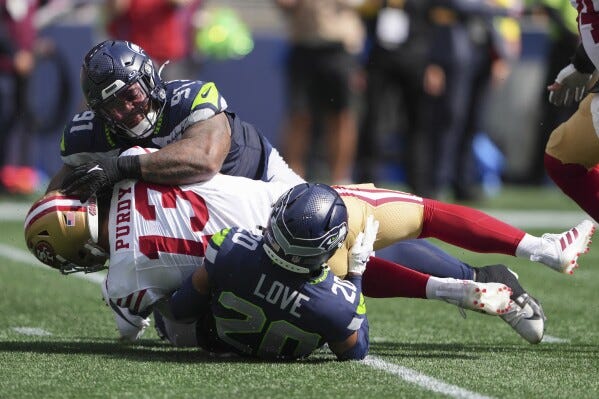Bad News on Brock Purdy's Toe
Turf toe is the weirdest injury I've ever had
I’ve long been waiting to expound on turf toe, the absolute weirdest injury I’ve ever had. And I’ve had it a long time — off and on for about 10 years. I’ve got a clear memory when it first happened. Underhill Field, pickup soccer. I kicked down at the ground as the ball rolled behind me, shooting a new kind of pain from the tip of my foot on up. It hurt a lot, but I expected the issue to be temporary. It wasn’t. For months and months, I kept accidentally re-injuring it, even in mundane non exercise settings. You can’t help it. The front foot gets used constantly and eventually, even when you assume you’re healed, it slams into a stair. Right back to square 1 again and again and…here I am, a decade later, nursing a turf toe injury from 3 weeks ago.
But the re-injury factor is not what makes turf toe interesting to me, and why I’ve been meaning for some time to discuss this exact topic. Unfortunately, my opportunity comes when the quarterback of the team I root for throws three interceptions on Monday Night Football. Oh well.
Brock Purdy sustained a turf toe (technically called a “metatarsophalangeal joint sprain”) in the season opener against the Seattle Seahawks and has missed 9 games. Backup Mac Jones played decent enough in Purdy’s absence so perhaps the pressure was on for newly paid QB1 to come back and perform. Purdy explained his status as, “not 100 percent by any means, but pretty close.” I, a turf toe sufferer, heard that and said, “Uh oh.” Because, in my experience, if you’re not done with turf toe, then turf toe is certainly not done with you.
Purdy returned two weeks ago against the Cardinals and played well. Then came Monday’s game against the Panthers. It was a Niners victory. I was also, in my opinion, by far the worst game of Purdy’s career. Yes, Purdy once got picked four times on Christmas against the Ravens two seasons ago, but that ugliness involved batted balls and getting hit as he threw. Last game he was spraying passes from a totally clean pocket. I’d never seen him straight up miss guys to this extent, driving throws far behind the receiver when unbothered by pressure.
Disclaimers abound here. I don’t know the extent of Purdy’s injury, what the 49ers are doing to mitigate it, or the extent to which it informed poor play. But I can tell you this: The results made complete sense to me, as someone who has nursed this injury for a decade.
If you don’t believe me, you can believe this week’s Sports Illustrated on the subject. Quoting QB coach Jordan Palmer in the article:
You use your big toe in terms of creating movement more than any other part of your foot. [Everything] connects to that big toe. You use it to decelerate. You use it to change direction. You use it in creating a movement, applying force to the ground to create leverage, to push your hips in the direction you want to go.
With quarterbacks, we often talk about “arm strength,” but the throwing motion involves so much more than the arm. As Aaron Rodgers reveals in the below clip, a lot of the force generated on high velocity throws comes from how your feet grip the ground.
It’s similar to golf, another sport where you leverage “ground forces” in service of whipping your hands. Here’s the trippy way that turf toe has impacted me in this setting, and I’d say it’s unlike any other injury I’ve had in this respect.
Coming off a re-injury of the toe, I’ll feel fine. Maybe there would be a slight stiffness, but I’m otherwise good. There’s no limp when I walk, and I could probably even run a few miles if I wanted to. But then I’ll go to the driving range, attempt a few whacks with the driver, and be astounded by how poorly it’s going. There’s suddenly no strength to the swing and the body won’t turn. In my head, it’s just me, screwing up. I just need to focus better. Then I’ll take a video and look at the footage.
The main problem is this: My body simply will not put pressure on the front of my trail foot, in a way I can’t even sense. It flinches, an involuntary movement similar to how an eye blinks in response to flashing light. In my head there’s no pain, and the signals to the body are all the same. But reflexively, outside of my consciousness, the foot will not stamp.
Anyone familiar with sports understands that our bodies can compensate or overcompensate for an injury. I’ve encountered this to a certain extent when I play basketball off an ankle sprain. Turf toe is different, though, at least for me. My body compensates in such a manner as to deceive me. It tells me I’m capable of far more than I actually am. In sparing me from further injury, it opens me up to embarrassing overconfidence. So, a full range session will involve no pain, but also no good shots.
“Turf toe” is an umbrella term describing a multitude of injuries, so experiences can vary. I’ve not exactly certain how it impacts the aforementioned Brock Purdy or the recovering Joe Burrow. What I can say, with some confidence, is that is a master underminer of full body motions like throwing a football. It’s bad because it comprises you; It’s worse because it’ll often trick you into thinking you’re not compromised.




